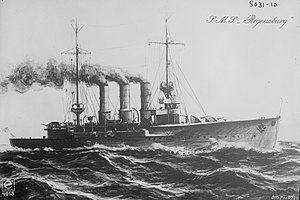 Postcard depicting a sketch of SMS Regensburg
| |
| Class overview | |
|---|---|
| Builders | Kiel Navy Yard, AG Weser |
| Operators | |
| Preceded by | Karlsruhe class |
| Succeeded by | Pillau class |
| Built | 1912–1915 |
| In commission | 1914–1944 |
| Planned | 2 |
| Completed | 2 |
| Lost | 1 |
| Retired | 1 |
| General characteristics | |
| Type | Light cruiser |
| Displacement | |
| Length | 142.70 m (468 ft 2 in) |
| Beam | 13.80 m (45 ft 3 in) |
| Draft | 5.75 m (18 ft 10 in) |
| Installed power |
|
| Propulsion |
|
| Speed | 27.5 kn (50.9 km/h; 31.6 mph) |
| Range | 5,500 nmi (10,200 km; 6,300 mi) at 12 knots (22 km/h; 14 mph) |
| Crew |
|
| Armament |
|
| Armor |
|
The Graudenz class of light cruisers was a class of two ships built for the Imperial German Navy. The class comprised SMS Graudenz and SMS Regensburg. The ships both were laid down in 1912, launched in October 1913 and April 1914 and commissioned in August 1914 and January 1915, respectively. They were armed with a main battery of twelve 10.5 cm (4.1 in) guns, though over the course of their careers, they were rearmed with seven more powerful 15 cm (5.9 in) guns. They displaced 6,382 t (6,281 long tons) at full load and were rated at a top speed of 27.5 knots (50.9 km/h; 31.6 mph)
Both ships saw extensive service during World War I, primarily in the reconnaissance forces of the High Seas Fleet. They participated in several raids on the British coast, screening for the battlecruisers of I Scouting Group. Regensburg saw heavy combat at the Battle of Jutland, the largest naval battle of the war; Graudenz had been damaged by a mine and was in dock for repairs at the time of the battle. Both were involved in the Wilhelmshaven mutiny at the end of the war. Following Germany's defeat, Graudenz was ceded to Italy and served as Ancona until 1937, when she was sold for scrap. Regensburg was transferred to France, where she served as Strasbourg until 1936, when she was converted into a barracks ship. She was ultimately scuttled in Lorient to protect the German U-boat pens there.